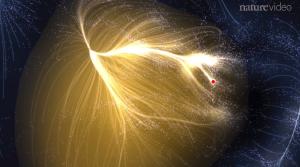Blog
Immeasurable Heaven
4 September 2014
 Nature
NatureGalaxies in the universe are not uniformly distributed, but are instead clumped together in groups known as clusters. These clusters are also clumped into larger superclusters, and superclusters are clumped into larger groups. If you image a bubble bath, and the way soapy-water bubble mix clumps to the intersection of the bubbles, the distribution of galaxies is somewhat similar.
Our own Milky Way is part of a local group which includes the Andromeda galaxy. Our local group is part of a larger cluster known as the Virgo Supercluster. This supercluster is connected to a larger group of superclusters, which includes the Norma supercluster, or “great attractor.” Of course this raises the question as to just how far this clustering goes. Is the Virgo-Norma-Great Attractor super-duper cluster part of an even larger structure? It turns out the answer is yes. This week in Nature a new paper announced the discovery of the largest supercluster found thus far, and our galaxy is a part of it.1 They named this supercluster Laniakea, which means “immeasurable heaven” in the Hawaiian language.
To map the Laniakea supercluster, the team used a new technique. Normally clusters are determined by using galactic redshift to measure distances. If galaxies are in a similar direction, and have a similar redshift, then they are likely part of a galactic cluster. In this work, the team measured the Doppler shift of various galaxies to determine their motion relative to us. From this they can also determine their motion relative to each other. By analyzing the motions, the team found a large supercluster of galaxies that all tend to move toward a central region. This galactic flow is an indication that the galaxies are gravitationally bound, and hence part of a supercluster. This method has been used before for things such as determining the location of the great attractor, but this new work has used it on a much larger scale.
So now we know that we are part of a supercluster of galaxies that spans about 500 million light years, and contains more than 100 quadrillion stars. Which makes “Immeasurable Heaven” pretty measurable after all.
Tully, R. Brent, et al. “The Laniakea supercluster of galaxies.” Nature 513.7516 (2014): 71-73. ↩︎